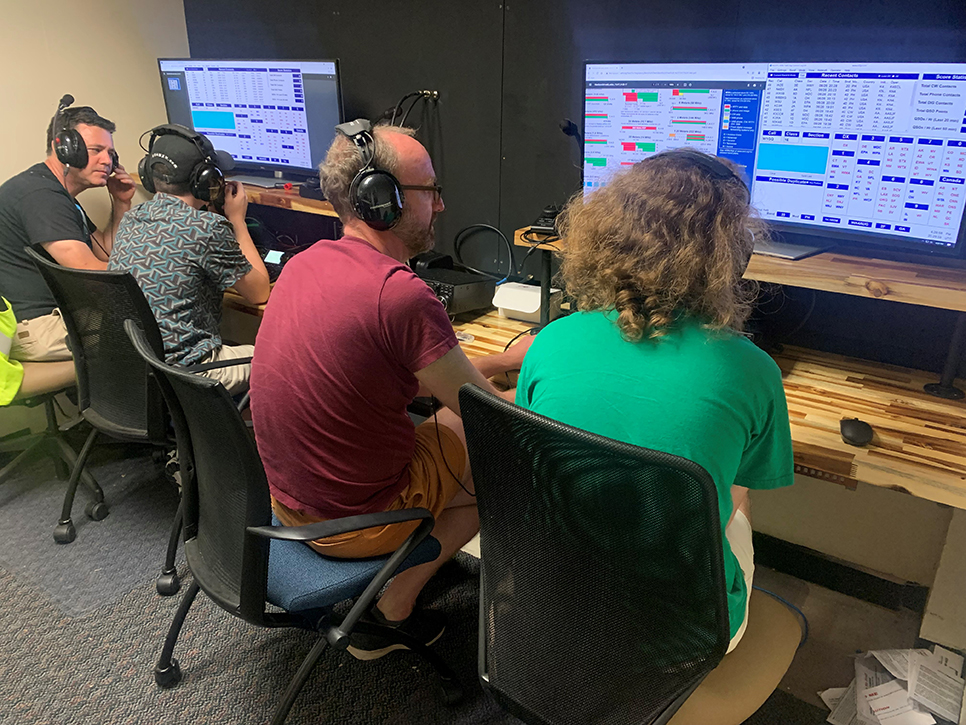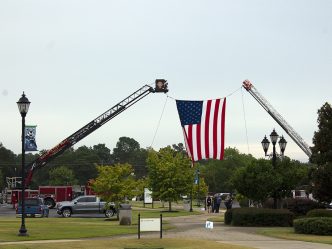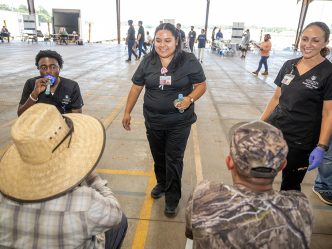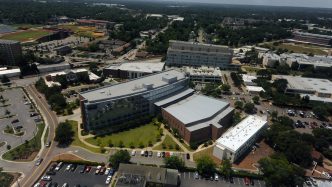For Dr. Andrew Goss, it’s a hobby. For Miller Birdsong, it’s a job necessity.
Either way they look at it, when it comes to amateur radio, the two get to play with some pretty cool toys.
Amateur radio (sometimes referred to as ham radio) is a popular hobby and service that brings people, electronics and communication together, according to the National Association for Amateur Radio, which is part of the American Radio Relay League in the USA. It represents over 170,000 Federal Communications Commission-licensed amateurs. People use ham radio to talk from across town, around the world or sometimes into space — all without the internet or cellphones.
Goss, a history professor at Augusta University, was first introduced to amateur radio when he was growing up. He said amateur radio practice and its culture has changed little in 30 years. When he started tinkering with it again a couple of years ago, he quickly felt comfortable again in that world.

“Antenna set-up, basic radio procedure and operator etiquette are all at root still the same,” said Goss, who is also the faculty advisor for the AU Ham Radio Club. “The biggest difference is how computing and digital technology is now involved in every aspect of amateur radio, and this has greatly expanded the reach and ease of amateur radio, opening up many additional possibilities for communicating efficiently and effectively using the same ham radio frequencies.”
Birdsong works for the Office of Critical Events Preparedness and Response (CEPaR) and uses amateur radio as part of his profession. He said he uses it in local situations or in small communities, such as when dealing with tornadoes, or in a larger regional event, such as Hurricane Matthew back in 2016, when communications can be disrupted for an extended period on time. Birdsong said having licensed and trained operators with the appropriate equipment and a readiness to deploy is critical to establishing an interim communications network.
AU’s Ham Radio Club was founded by Darby Wills, a student, back in September 2019, but when the pandemic began in 2020, their gatherings were paused. During that time, with the help of CEPaR, they still have been able to develop an active community of licensed people who are familiar with FCC regulations.
Birdsong said some of the biggest misconceptions people who aren’t familiar with amateur radio might have is believing if you have a radio, anyone can operate it.
“Other communication tools: cellphone, public safety radios or even C.B. radio, by design, require virtually no training or experience … amateur radio, however, requires both training and experience in order to operate, much less to be proficient,” he said.
Birdsong said years ago, the U.S. Department of Health and Human Services developed a nationwide model to support health care providers, within communities, to become more resilient and able to recover more quickly from disasters. Each state and territory across the nation developed regional health care coalitions to facilitate this effort locally.
“The East Central Georgia Healthcare Coalition is a partnership between Augusta University Medical Center and the Georgia Department of Public Health, with this disaster resilience as its mission,” said Birdsong, who also mentioned AUMC recently received a grant from the U.S. Department of Health and Human Services to expand its regional emergency operation center’s capabilities. He said those funds were used to acquire equipment to fulfill several needs, including radios.
“CEPaR manages and supports the coalition, which is composed of health care providers of all types and organizations that support them. These include hospitals, long-term care facilities, EMS services, home health, medical practices, pharmacies, durable medical equipment providers, medical supply providers, insurance providers, state agencies and local governments. The coalition provides training, information sharing, emergency communications, logistical support and maintains a cache of emergency equipment and supplies.”
Recently, Goss, Birdsong and the rest of the AU Ham Radio Club participated in ARRL Field Day, which is the single most popular on-the-air event held annually in the US and Canada. On the fourth weekend of June, thousands of radio amateurs gather with their clubs or simply with friends to operate from remote locations.
The contest part of the day is to contact as many other stations as possible and to learn to operate radio gear in abnormal situations and less-than-optimal conditions.
Goss said field day runs for a 27-hour period. He said most stations are limited to operating the first 24 hours and antennas can be set up as early as the Friday before.

“The object is to test your station and its antennas under adverse conditions by contacting as many amateur radio stations on various frequencies using different modes (Morse Code, voice and digital),” he said. “There are numerous categories: some stations set up portably in the field using battery or generator power, while some go further and activate their station using solar power only. Contestants usually enter as a team and can operate between one and 20 radios at the same time.
“This past year at Augusta University, we entered with two radios in the Emergency Operations Center category, utilizing the new emergency facility at CEPaR. Using our two stations and temporary antennas, we made over 1,100 contacts in 24 hours.”
Results from the event will be known by the end of the year.
In Goss’s opinion, amateur radio frequencies are the last remaining place in the radio spectrum where individuals can experiment with wireless communications. University clubs such as the one at Augusta University “create a community where students as well as faculty and staff can together learn the skills and technologies of radio communication.”
“This includes not only fun with experimentation and operating, but also can lead to creativity and innovation in addressing communications challenges in our community, including, in particular, as it relates to emergency communication. And despite the ubiquity of modern communications systems, ham radio has been called into action during emergencies, as it can and does provide communications support in real disasters.”
For more information on amateur radio or the health care coalition, email or call 706-792-2407.
 Augusta University
Augusta University




